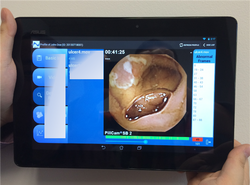GISentinel - AI on Capsule Endoscopic Imaging
GISentinel - Automated Capsule Endoscopic Video Analysis Software
Originally funded by NIH, GISentinel was developed in collaboration with Mayo Clinic for automated gastrointestinal disease tracking and classification in the capsule endoscopic (CE) videos. On-going clinic studies at Mayo Clinic are showing a significantly higher level of accuracy for ulcer, bleeding, and polyps detection. The developed 2D/3D GISentinel software system is the first software tool that utilizes both 2D and 3D information to rapidly detect and accurately diagnose abnormalities from capsule endoscopic images. This software product is aimed to eliminate the traditional manual review process, save millions of dollars for patients, and improve the accuracy of the diagnosis process.
Currently, GISentinel runs on both PC and Android platforms. For more product information or if you would like to obtain an evaluation copy, please contact info@xyken.com.
 |  |
|---|---|
 |  |
 |
Background Information
Endoscopy has been in clinic use for almost three decades now. Traditionally, an endoscope utilizes a lens system, fiber optics, and an illumination light source to visualize the interiors of body cavities and joints. The endoscopic procedure, with 30 years since its inception, still remains a painful operation to the patient. The other major drawback that the flexible or rigid endoscopes could not address in those years is the small bowel imaging. In fact, the small intestine remained the final frontier for endoscopic instruments until the advent of wireless Capsule Endoscopy (CE) less than 10 years ago. The CE technology uses a pill-size wireless capsule camera to capture and transmit digital images of the inner surface structure after it is swallowed and propelled via peristalsis through the GI tract. These images are then reviewed by a gastrointestinal (GI) doctor for disease diagnosis.
Non-invasive video capsule endoscopy has indeed revolutionized the diagnosis of small-bowel diseases like obscure bleeding and Crohn’s disease. However, currently capsule endoscopy (CE) manufacturer’s video display and diagnosis software (SW) such as RAPID from Given Imaging and EndoCapsule from Olympus is still in the initial technological stage, as their SW only offers video playing and simple landmark labeling capability. Each recorded CE video has to be manually reviewed frame by frame by a GI doctor. With normal video length of about 8 hours, the manual review process typically ranges from 2 to 3 hours. This significantly increases the procedure costs. It is evident that intelligent imaging SW is greatly needed to automate the image review process. Unfortunately, there is no automated image analysis tool or product currently available on the market that addresses this issue. Automated video review process will not only save millions of dollars for patients by reducing the expensive labor hours, but also improve video review consistency, accuracy, and completeness of disease findings. Clearly, low cost CE procedure through GISentinel will facilitate mass acceptance for earlier diagnosis and significantly reduce the chance of developing cancers.

